Indexed in: ESCI, Scopus, PubMed,
PubMed Central, CAS, DOAJ, KCI
PubMed Central, CAS, DOAJ, KCI
FREE article processing charge

Previous issues
- Page Path
- HOME > Browse Articles > Previous issues
Editorial
- Journal title changes from Yeungnam University Journal of Medicine to Journal of Yeungnam Medical Science
- So-Young Park
- J Yeungnam Med Sci. 2022;39(1):1-2. Published online December 22, 2021
- DOI: https://doi.org/10.12701/yujm.2021.01655

- 3,641 View
- 99 Download
- 1 Web of Science
- 1 Crossref
Review articles
- Ocular adnexal mucosa-associated lymphoid tissue lymphoma: a narrative review
- Hyun Uk Chung, Jun Hyuk Son
- J Yeungnam Med Sci. 2022;39(1):3-11. Published online September 15, 2021
- DOI: https://doi.org/10.12701/yujm.2021.01263
- 5,003 View
- 154 Download
- 7 Web of Science
- 6 Crossref
-
 Abstract
Abstract
 PDF
PDF - Lymphoma is the most common primary tumor of the orbit, accounting for 55% of all orbital malignancies. When divided into histopathological subtypes, extranodal marginal zone lymphoma of mucosa-associated lymphoid tissue (MALT lymphoma) comprises the largest proportion. Clinical manifestations are unspecific, but in patients with slow-growing painless orbital mass, or red conjunctival lesion suggestive of ‘salmon patch’, ocular adnexa lymphoma (OAL) should be suspected. Although the pathogenetic mechanism of ocular adnexal MALT lymphoma (OAML) is not yet fully understood, the relationship between OAML and Chlamydia psittaci has been hypothesized recently, similar to that between gastric MALT lymphoma and Helicobacter pylori. This suggests a new treatment option for OAML; bacterial eradication therapy with systemic antibiotics. Several other treatment methods for OAML have been introduced, but no treatment guidelines have been established yet. In this article, we summarize the current knowledge on the clinical features, pathogenesis, diagnostic methods, therapeutic strategies, and prognosis of OAML.
-
Citations
Citations to this article as recorded by- Unusual Pediatric Red Eye
Carson W. Ercanbrack, Jamal O. Azhari, David B. Warner, Maher Abulfaraj, Abdelrahman M. Elhusseiny
The Journal of Pediatrics.2024; 267: 113924. CrossRef - The Possible Role of Pathogens and Chronic Immune Stimulation in the Development of Diffuse Large B-Cell Lymphoma
Lajos Gergely, Miklos Udvardy, Arpad Illes
Biomedicines.2024; 12(3): 648. CrossRef - Radiomics analysis of T1WI and T2WI magnetic resonance images to differentiate between IgG4-related ophthalmic disease and orbital MALT lymphoma
Yuchao Shao, Yuqing Chen, Sainan Chen, Ruili Wei
BMC Ophthalmology.2023;[Epub] CrossRef - Etiopathogenesis of primary acquired nasolacrimal duct obstruction (PANDO)
Mohammad Javed Ali
Progress in Retinal and Eye Research.2023; 96: 101193. CrossRef - The Biology of Ocular Adnexal Marginal Zone Lymphomas
Patricia Johansson, Anja Eckstein, Ralf Küppers
Cancers.2022; 14(5): 1264. CrossRef - One Case of Conjunctival MALT Lymphoma and Literature Review
旭霞 李
Advances in Clinical Medicine.2022; 12(08): 7586. CrossRef
- Unusual Pediatric Red Eye
- Anatomical endoscopic enucleation of the prostate for bladder outlet obstruction: a narrative review
- Tae Hyo Kim, Phil Hyun Song
- J Yeungnam Med Sci. 2022;39(1):12-17. Published online November 9, 2021
- DOI: https://doi.org/10.12701/yujm.2021.01522

- 3,370 View
- 66 Download
- 2 Web of Science
- 2 Crossref
-
 Abstract
Abstract
 PDF
PDF - Anatomical endoscopic enucleation of the prostate (AEEP) differs from other endoscopic modalities for bladder outlet obstruction (BOO) because it extracts the whole benign prostatic hyperplasia component. AEEP has been launched for almost 40 years as a first-line treatment method for BOO regardless of prostate size according to several guidelines. However, it remains underperformed worldwide. In this review article, we elaborate on the advantages and disadvantages of AEEP compared to other surgical modalities for BOO to investigate its efficacy and safety as a gold standard surgical management option for males with BOO.
-
Citations
Citations to this article as recorded by- From Consensus to Validation: A Multicenter Study for Design and Development of a Holmium Laser Enucleation of the Prostate Hydrogel Simulation Platform
Lauren Shepard, Nathan Schuler, Gopal Narang, Shaan Setia, Akhil Das, Nicole Miller, Mitchell Humphreys, Amy Krambeck, Ahmed Ghazi
Journal of Endourology.2024; 38(1): 60. CrossRef - Robotic Assisted Simple Prostatectomy versus Holmium Laser Enucleation of the Prostate for Patients with Huge Benign Prostatic Hyperplasia
Hye Soo Kim, Yu Seob Shin
The World Journal of Men's Health.2023; 41(4): 753. CrossRef
- From Consensus to Validation: A Multicenter Study for Design and Development of a Holmium Laser Enucleation of the Prostate Hydrogel Simulation Platform
Original articles
- Puncture needle with a hard plastic sheath and plastic wings minimizes repuncture attempts in ultrasound-guided paracentesis: a retrospective case-control study
- Il Wan Son, Suk Kim, Seung Baek Hong, Nam Kyung Lee, Mi Ri Jeong, Sung Yong Han, Hyun Young Woo
- J Yeungnam Med Sci. 2022;39(1):18-23. Published online July 12, 2021
- DOI: https://doi.org/10.12701/yujm.2021.01109
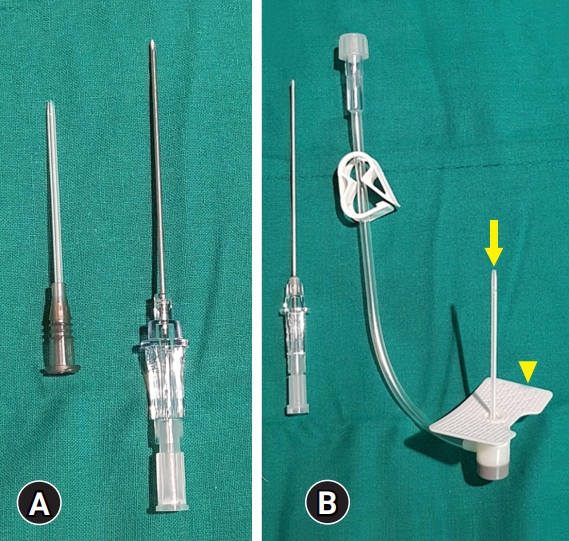
- 3,622 View
- 84 Download
-
 Abstract
Abstract
 PDF
PDF - Background
This study was performed to evaluate periprocedural factors, complications, and repuncture rate of the newly developed puncture needle and compare it with the routinely used puncture needle for ultrasound (US)-guided paracentesis.
Methods
We retrospectively identified 137 patients who underwent US-guided paracentesis between July 2018 and March 2019. Among them, 82 patients underwent US-guided paracentesis with a newly developed puncture needle. The other 55 patients underwent US-guided paracentesis with a routinely used puncture needle. The periprocedural factors, complications, and repuncture rate were compared between the two groups using the Mann-Whitney U test and Fisher exact test. The repuncture-associated factors were assessed using logistic regression analysis.
Results
There were no major or minor complications in either group. The rate of repuncture was significantly lower in the group using the newly developed puncture needle compared with the group using the routinely used puncture needle (p=0.01). The duration of the procedure was significantly shorter with the newly developed puncture needle compared with the routinely used puncture needle (p=0.01). In univariate analysis, the thickness of the abdominal wall (p=0.04) and the use of the newly developed puncture needle (p=0.01) were significantly associated with the rate of repuncture. In multivariate analysis, only the use of the newly developed puncture needle was significantly associated with the rate of repuncture.
Conclusion
Using this novel puncture needle with a hard plastic sheath and plastic wings, the rate of repuncture and the duration of the procedure were decreased without complications of US-guided paracentesis.
- Magnetic resonance imaging texture analysis for the evaluation of viable ovarian tissue in patients with ovarian endometriosis: a retrospective case-control study
- Dayong Lee, Hyun Jung Lee
- J Yeungnam Med Sci. 2022;39(1):24-30. Published online July 15, 2021
- DOI: https://doi.org/10.12701/yujm.2021.01165
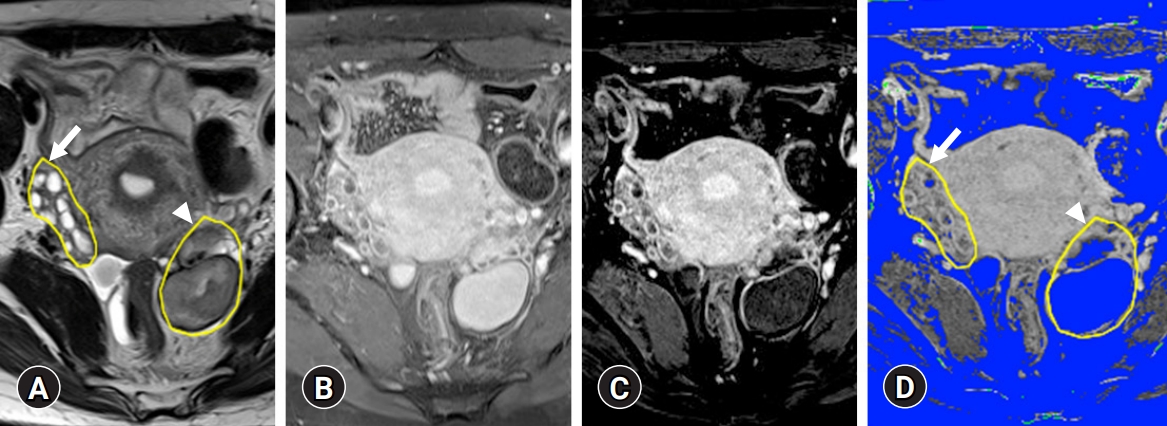
- 3,794 View
- 113 Download
-
 Abstract
Abstract
 PDF
PDF - Background
Texture analysis has been used as a method for quantifying image properties based on textural features. The aim of the present study was to evaluate the usefulness of magnetic resonance imaging (MRI) texture analysis for the evaluation of viable ovarian tissue on the perfusion map of ovarian endometriosis.
Methods
To generate a normalized perfusion map, subtracted T1-weighted imaging (T1WI), T1WI and contrast-enhanced T-WI with sequences were performed using the same parameters in 25 patients with surgically confirmed ovarian endometriosis. Integrated density is defined as the sum of the values of the pixels in the image or selection. We investigated the parameters for texture analysis in ovarian endometriosis, including angular second moment (ASM), contrast, correlation, inverse difference moment (IDM), and entropy, which is equivalent to the product of area and mean gray value.
Results
The perfusion ratio and integrated density of normal ovary were 0.52±0.05 and 238.72±136.21, respectively. Compared with the normal ovary, the affected ovary showed significant differences in total size (p<0.001), fractional area ratio (p<0.001), and perfusion ratio (p=0.010) but no significant differences in perfused tissue area (p=0.158) and integrated density (p=0.112). In comparison of parameters for texture analysis between the ovary with endometriosis and the contralateral normal ovary, ASM (p=0.004), contrast (p=0.002), IDM (p<0.001), and entropy (p=0.028) showed significant differences. A linear regression analysis revealed that fractional area had significant correlations with ASM (r2=0.211), IDM (r2=0.332), and entropy (r2=0.289).
Conclusion
Magnetic resonance texture analysis could be useful for the evaluation of viable ovarian tissues in patients with ovarian endometriosis.
- Impact of an emergency department resident strike during the coronavirus disease 2019 (COVID-19) pandemic in Daegu, South Korea: a retrospective cross-sectional study
- Yo Han Cho, Jae Wan Cho, Hyun Wook Ryoo, Sungbae Moon, Jung Ho Kim, Sang-Hun Lee, Tae Chang Jang, Dong Eun Lee
- J Yeungnam Med Sci. 2022;39(1):31-38. Published online August 10, 2021
- DOI: https://doi.org/10.12701/yujm.2021.01130

- 4,548 View
- 96 Download
- 5 Web of Science
- 5 Crossref
-
 Abstract
Abstract
 PDF
PDF - Background
To prepare for future work stoppages in the medical industry, this study aimed to identify the effects of healthcare worker strikes on the mortality rate of patients visiting the emergency department (ED) at six training hospitals in Daegu, Korea.
Methods
We used a retrospective, cross-sectional, multicenter design to analyze the medical records of patients who visited six training hospitals in Daegu (August 21–September 8, 2020). For comparison, control period 1 was set as the same period in the previous year (August 21–September 8, 2019) and control period 2 was set as July 1–19, 2020. Patient characteristics including age, sex, and time of ED visit were investigated along with mode of arrival, length of ED stay, and in-hospital mortality. The experimental and control groups were compared using t-tests, and Mann-Whitney U-test, chi-square test, and Fisher exact tests, as appropriate. Univariate logistic regression was performed to identify significant factors, followed by multivariate logistic regression analysis.
Results
During the study period, 31,357 patients visited the ED, of which 7,749 belonged to the experimental group. Control periods 1 and 2 included 13,100 and 10,243 patients, respectively. No significant in-hospital mortality differences were found between study periods; however, the results showed statistically significant differences in the length of ED stay.
Conclusion
The ED resident strike did not influence the mortality rate of patients who visited the EDs of six training hospitals in Daegu. Furthermore, the number of patients admitted and the length of ED stay decreased during the strike period. -
Citations
Citations to this article as recorded by- Impact of junior doctor strikes on patient flow in the emergency department: a cross-sectional analysis
Svenja Ravioli, Raeesa Jina, Omar Risk, Fleur Cantle
European Journal of Emergency Medicine.2024; 31(1): 53. CrossRef - What Do Trainees Want? The Rise of House Staff Unions
Debra Malina, Lisa Rosenbaum
New England Journal of Medicine.2024; 390(3): 279. CrossRef - Experience of operating a medical humanities course at one medical school during the COVID-19: a retrospective study
Yu Ra Kim, Hye-won Shin, Young Hwan Lee, Seong-Yong Kim
Journal of Yeungnam Medical Science.2023; 40(2): 179. CrossRef - A deliberative framework to assess the justifiability of strike action in healthcare
Ryan Essex
Nursing Ethics.2023;[Epub] CrossRef - Study on the Learning Environment of Medical Students in the COVID-19
Yu Ra Kim, Hye Jin Park, Saeyoon Kim
Keimyung Medical Journal.2023; 42(2): 80. CrossRef
- Impact of junior doctor strikes on patient flow in the emergency department: a cross-sectional analysis
- Clinical investigation on acute pyelonephritis without pyuria: a retrospective observational study
- Hyung Keun Song, Dong Hyuk Shin, Ji Ung Na, Sang Kuk Han, Pil Cho Choi, Jang Hee Lee
- J Yeungnam Med Sci. 2022;39(1):39-45. Published online August 11, 2021
- DOI: https://doi.org/10.12701/yujm.2021.01207

- 6,051 View
- 183 Download
-
 Abstract
Abstract
 PDF
PDF - Background
The current guidelines for the diagnosis of acute pyelonephritis (APN) recommend that APN be diagnosed based on the clinical features and the presence of pyuria. However, we observed that some of the patients who are diagnosed with APN do not have characteristic clinical features or pyuria at the initial examination. We performed this study to investigate the characteristics of APN without pyuria.
Methods
A retrospective, cross-sectional study was conducted on 391 patients diagnosed with APN based on clinical and radiologic findings, between 2015 and 2019. The clinical features, laboratory results, and computed tomography (CT) findings were compared between patients with normal white blood cell (WBC) counts and those with abnormal WBC counts (WBC of 0–5/high power field [HPF] vs. >5/HPF) in urine.
Results
More than 50% of patients with APN had no typical urinary tract symptoms and one-third of them had no costovertebral angle (CVA) tenderness. Eighty-eight patients (22.5%) had normal WBC counts (0–5/HPF) on urine microscopy. There was a negative correlation between pyuria (WBC of >5/HPF) and previous antibiotic use (odds ratio, 0.249; 95% confidence interval, 0.140–0.441; p<0.001), and the probability of pyuria was reduced by 75.1% in patients who took antibiotics before visiting the emergency room.
Conclusion
The diagnosis of APN should not be overlooked even if there are no typical clinical features, or urine microscopic examination is normal. If a patient has already taken antibiotics at the time of diagnosis, imaging studies such as CT should be performed more actively, regardless of the urinalysis results.
- Increase in blood glucose level and incidence of diabetic ketoacidosis in children with type 1 diabetes mellitus in the Daegu-Gyeongbuk area during the coronavirus disease 2019 (COVID-19) pandemic: a retrospective cross-sectional study
- Mi Seon Lee, Rosie Lee, Cheol Woo Ko, Jung Eun Moon
- J Yeungnam Med Sci. 2022;39(1):46-52. Published online August 26, 2021
- DOI: https://doi.org/10.12701/yujm.2021.01221

- 6,100 View
- 97 Download
- 8 Web of Science
- 11 Crossref
-
 Abstract
Abstract
 PDF
PDF - Background
The coronavirus disease 2019 (COVID-19) outbreak in the Daegu-Gyeongbuk area in 2020 has caused difficulties in the daily life and hospital care of children with type 1 diabetes mellitus (T1DM). We detected an increase in blood sugar levels in these children and the number of patients hospitalized with more severe diabetic ketoacidosis (DKA) compared to those before COVID-19.
Methods
This single-center study was conducted at Kyungpook National University Children’s Hospital. The following patient groups were included; 45 returning patients diagnosed with T1DM and undergoing insulin treatment for more than 2 years and 20 patients newly diagnosed with T1DM before and after COVID-19 were selected by age matching. Returning patients before and after the outbreak were selected, and changes in hemoglobin A1c (HbA1c) levels were retrospectively reviewed. The HbA1c levels and severity of symptoms in newly diagnosed patients during hospitalization were examined.
Results
HbA1c levels in returning patients with T1DM were significantly increased after COVID-19 (before, 7.70%±1.38% vs. after, 8.30%±2.05%; p=0.012). There were 10 and 10 newly diagnosed patients before and after COVID-19, respectively. The proportion of patients with drowsiness and dyspnea at the time of admission was higher after COVID-19 than before (before, 2 of 10 vs. after, 4 of 10). The HbA1c levels were higher in newly diagnosed patients hospitalized after COVID-19 than before (before, 11.15% vs. after, 13.60%; p=0.036).
Conclusion
Due to COVID-19 in the Daegu-Gyeongbuk area, there was an increase in blood glucose levels in children with T1DM and in the incidence of severe DKA in newly diagnosed diabetes mellitus patients. -
Citations
Citations to this article as recorded by- Incidence of diabetic ketoacidosis during COVID-19 pandemic: a meta-analysis of 124,597 children with diabetes
Anas Elgenidy, Ahmed K. Awad, Khaled Saad, Mostafa Atef, Hatem Helmy El-Leithy, Ahmed A. Obiedallah, Emad M. Hammad, Faisal-Alkhateeb Ahmad, Ahmad M. Ali, Hamad Ghaleb Dailah, Amira Elhoufey, Samaher Fathy Taha
Pediatric Research.2023; 93(5): 1149. CrossRef - Comments on Rahmati et al., The global impact of COVID‐19 pandemic on the incidence of pediatric new‐onset type 1 diabetes and ketoacidosis: A systematic review and meta‐analysis. J Med Virol. 2022; 1‐16 (doi: 10.1002/jmv.27996)
Joachim Rosenbauer, Anna Stahl‐Pehe, Sabrina Schlesinger, Oliver Kuß
Journal of Medical Virology.2023;[Epub] CrossRef - Impact of the COVID-19 Pandemic on Children and Adolescents with New-Onset Type 1 Diabetes
Clemens Kamrath, Alexander J. Eckert, Reinhard W. Holl, Joachim Rosenbauer, Andrea Scaramuzza
Pediatric Diabetes.2023; 2023: 1. CrossRef - Difficulties in differential diagnosis of carbohydrate metabolism disorders in patients with coronavirus infection in real clinical practice. Case report
Tatyana N. Markova, Mukhamed S. Stas, Valentina V. Chibisova, Anastasia A. Anchutina
Consilium Medicum.2023; 25(4): 241. CrossRef - Endocrinological Involvement in Children and Adolescents Affected by COVID-19: A Narrative Review
Valeria Calcaterra, Veronica Maria Tagi, Raffaella De Santis, Andrea Biuso, Silvia Taranto, Enza D’Auria, Gianvincenzo Zuccotti
Journal of Clinical Medicine.2023; 12(16): 5248. CrossRef - Glycemic control and complications of type 2 diabetes mellitus in children and adolescents during the COVID-19 outbreak
Kyeong Eun Oh, Yu Jin Kim, Ye Rim Oh, Eungu Kang, Hyo-Kyoung Nam, Young-Jun Rhie, Kee-Hyoung Lee
Annals of Pediatric Endocrinology & Metabolism.2023; 28(4): 275. CrossRef - Incidence of Diabetic Ketoacidosis Among Pediatrics With Type 1 Diabetes Prior to and During COVID-19 Pandemic: A Meta-Analysis of Observational Studies
Osamah M. Alfayez, Kholood S. Aldmasi, Nada H. Alruwais, Nouf M. Bin Awad, Majed S. Al Yami, Omar A. Almohammed, Abdulaali R. Almutairi
Frontiers in Endocrinology.2022;[Epub] CrossRef - Comparison of Initial Presentation of Pediatric Diabetes Before and During the Coronavirus Disease 2019 Pandemic Era
Yoonha Lee, Minseung Kim, Kyeongeun Oh, Eungu Kang, Young-Jun Rhie, Jieun Lee, Yong Hee Hong, Young-Lim Shin, Jae Hyun Kim
Journal of Korean Medical Science.2022;[Epub] CrossRef - The global impact of COVID‐19 pandemic on the incidence of pediatric new‐onset type 1 diabetes and ketoacidosis: A systematic review and meta‐analysis
Masoud Rahmati, Maryam Keshvari, Shahrzad Mirnasuri, Dong K. Yon, Seung W. Lee, Jae Il Shin, Lee Smith
Journal of Medical Virology.2022; 94(11): 5112. CrossRef - COVID-19 and diabetes: What do we know so far?
Prakash Gangadaran, Himabindu Padinjarathil, Shri Hari Subhashri Rajendran, Manasi P Jogalekar, Chae Moon Hong, Baladhandapani Aruchamy, Uma Maheswari Rajendran, Sridharan Gurunagarajan, Anand Krishnan, Prasanna Ramani, Kavimani Subramanian
Experimental Biology and Medicine.2022; 247(15): 1330. CrossRef - Stress hyperglycemia, Diabetes mellitus and COVID-19 infection: The impact on newly diagnosed type 1 diabetes
Ioanna Farakla, Theano Lagousi, Michael Miligkos, Nicolas C. Nicolaides, Ioannis-Anargyros Vasilakis, Maria Mpinou, Maria Dolianiti, Elina Katechaki, Anilia Taliou, Vasiliki Spoulou, Christina Kanaka-Gantenbein
Frontiers in Clinical Diabetes and Healthcare.2022;[Epub] CrossRef
- Incidence of diabetic ketoacidosis during COVID-19 pandemic: a meta-analysis of 124,597 children with diabetes
Case reports
- Multilocular cystic hemangioma of the liver mimicking mucinous cystic neoplasm: a case report
- Nam Kyung Lee, Suk Kim, Seung Baek Hong, So Jeong Lee, Hyung Il Seo
- J Yeungnam Med Sci. 2022;39(1):53-57. Published online April 7, 2021
- DOI: https://doi.org/10.12701/yujm.2021.00969

- 9,029 View
- 106 Download
-
 Abstract
Abstract
 PDF
PDF - Hepatic hemangiomas infrequently exhibit atypical imaging features, which may cause diagnostic confusion with hepatic malignancies and lead to unnecessary surgery. We report a rare case of multilocular cystic hemangioma of the liver mimicking a mucinous cystic neoplasm of the liver in a 48-year-old female, focusing on computed tomography and magnetic resonance imaging features and their differential diagnosis.
- Mega cisterna magna in bipolar mood disorder: a case report
- Esra Yazici, Sefanur Kose, Yasemin Gunduz, Elif Merve Kurt, Ahmet Bulent Yazici
- J Yeungnam Med Sci. 2022;39(1):58-61. Published online April 15, 2021
- DOI: https://doi.org/10.12701/yujm.2020.00864

- 7,189 View
- 100 Download
- 2 Web of Science
- 3 Crossref
-
 Abstract
Abstract
 PDF
PDF - Mega cisterna magna (MCM), one of the members of the Dandy-Walker complex, is a developmental malformation of the posterior fossa that is larger than 10 mm but morphologically does not affect the vermis and cerebellar hemispheres. Reports of psychiatric disorders associated with this anomaly are rare. We present the case of a patient with MCM who presented with a psychotic manic attack and was diagnosed with bipolar disorder. A 28-year-old female, single housewife, university graduate, presented with irritability, decreased sleep and appetite, distraction, and agitation. The patient also had a delusion of reference. In the clinical follow-up, an increase in energy and an increase in the amount of speech were observed. Her neurological examination was normal, and cranial magnetic resonance imaging revealed an MCM. The relationship and clinical significance of MCM with psychosis and mood disorders have not yet been fully elucidated. It is not known whether this association is accidental or based on etiological commonality. The purpose of this case report is to review the relationship between the cerebellum and psychiatric symptoms and to contribute to the literature.
-
Citations
Citations to this article as recorded by- Radiological characteristics of the posterior fossa of the fetal skull and presentation of a rare case of antenatal screening for Dandy-Walker malformation using antenatal fetal ultrasound and MRI
Ayoub Amghar, Imane El Abbassi, Jalal Mohammed, Assal Asmaa, Lamrissi Amine, Said Bouhya
International Journal of Surgery Case Reports.2024; 115: 109037. CrossRef - Tic-Related Obsessive–Compulsive and Eating Disorders in Dandy–Walker Variant: A Case Report and Systematic Reappraisal of Psychiatric Profiles
Riccardo Bortoletto, Anna Candolo, Alessandra Nicotra, Luana Saetti, Laura Perini, Matteo Balestrieri, Marco Colizzi, Carla Comacchio
Brain Sciences.2024; 14(4): 362. CrossRef - Benzodiazepines for Treatment-Resistant Major Depressive Disorder and Obsessive-Compulsive Disorder With Comorbid Mega Cisterna Magna
Arifah Ismail, Asrenee Ab Razak, Khairil Amir Sayuti, Picholas Kian Ann Phoa
Cureus.2023;[Epub] CrossRef
- Radiological characteristics of the posterior fossa of the fetal skull and presentation of a rare case of antenatal screening for Dandy-Walker malformation using antenatal fetal ultrasound and MRI
- Adrenal insufficiency development during chemotherapy plus anti-programmed death receptor-1 monoclonal antibody (tislelizumab) therapy in patients with advanced gastric cancer: two case reports
- Jin Ho Baek
- J Yeungnam Med Sci. 2022;39(1):62-66. Published online April 19, 2021
- DOI: https://doi.org/10.12701/yujm.2021.00934
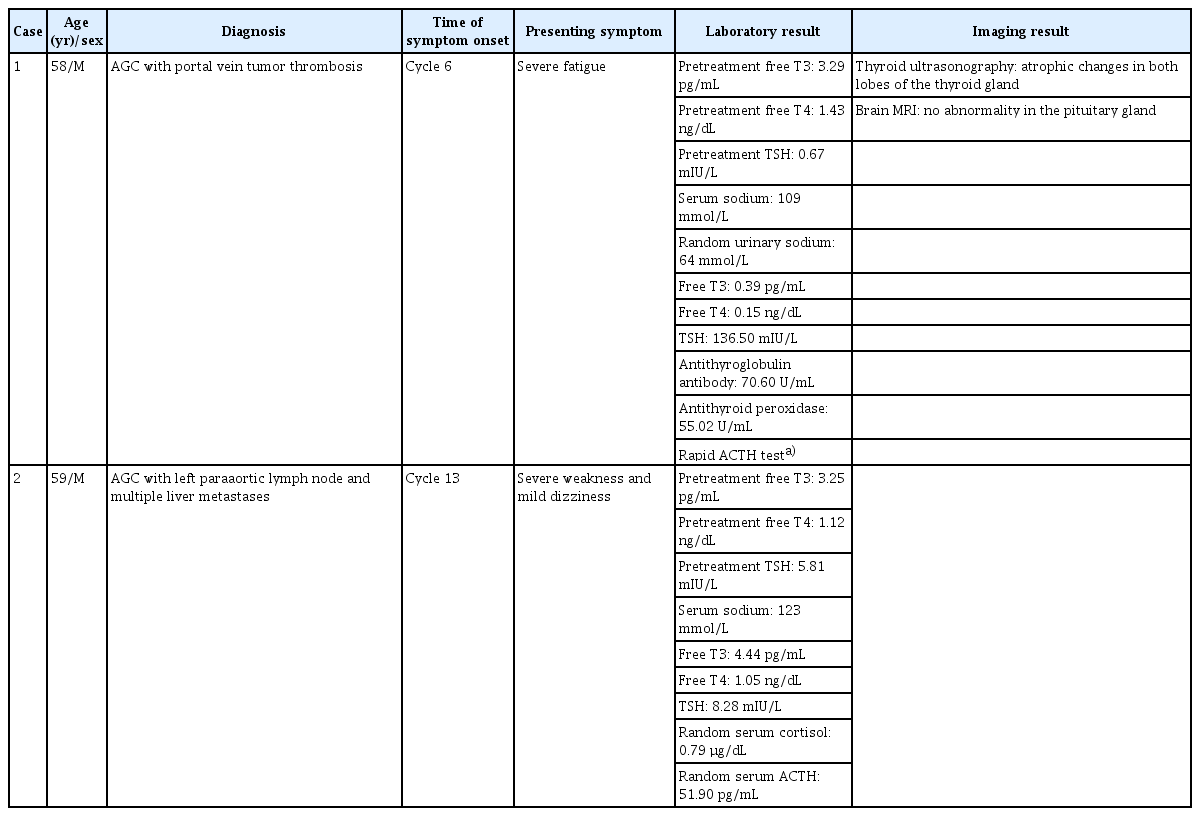
- 5,192 View
- 102 Download
- 3 Web of Science
- 4 Crossref
-
 Abstract
Abstract
 PDF
PDF - Immune checkpoint inhibitor (ICI)-associated adrenal insufficiency is rare but may become a serious adverse event in patients treated with ICIs. The present case report documents two cases of adrenal insufficiency developed during chemotherapy plus tislelizumab (百泽安, Baize’an; BeiGene Ltd.) therapy in patients with advanced gastric cancer. Adrenal insufficiency developed after 6 and 13 cycles of treatment and was well controlled with hydrocortisone. The patients also developed hypothyroidism, which was managed with levothyroxine. Two patients showed a partial response, and one patient out of two achieved a near-complete response, sustaining over 11 months. Increased awareness of ICI-related adrenal insufficiency is crucial for early detection and prompt management of patients treated with ICIs.
-
Citations
Citations to this article as recorded by- Immune checkpoint inhibitor-related adrenal hypofunction and Psoriasisby induced by tislelizumab: A case report and review of literature
Yisi Deng, Manling Huang, Runpei Deng, Jun Wang
Medicine.2024; 103(12): e37562. CrossRef - Severe thyrotoxicosis induced by tislelizumab: a case report and literature review
Liman Huo, Chao Wang, Haixia Ding, Xuelian Shi, Bin Shan, Ruoying Zhou, Ping Liang, Juan Hou
Frontiers in Oncology.2023;[Epub] CrossRef - Immune-related adverse events with severe pain and ureteral expansion as the main manifestations: a case report of tislelizumab-induced ureteritis/cystitis and review of the literature
Qihao Zhou, Zhiquan Qin, Peiyuan Yan, Qunjiang Wang, Jing Qu, Yun Chen
Frontiers in Immunology.2023;[Epub] CrossRef - Isolated Renal Calyceal Urothelial Carcinoma Effectively Treated With PD-1 Inhibitor Alone: A Case Report And Literature Review
Shihao Li, Yi Zhu, Zhijian Xu, Jianjun Liu, Hongwei Liu
Frontiers in Oncology.2022;[Epub] CrossRef
- Immune checkpoint inhibitor-related adrenal hypofunction and Psoriasisby induced by tislelizumab: A case report and review of literature
- Coinfection of Sphingomonas paucimobilis meningitis and Listeria monocytogenes bacteremia in an immunocompetent patient: a case report
- Sang Woon Bae, Jong Ho Lee
- J Yeungnam Med Sci. 2022;39(1):67-71. Published online June 7, 2021
- DOI: https://doi.org/10.12701/yujm.2021.01074
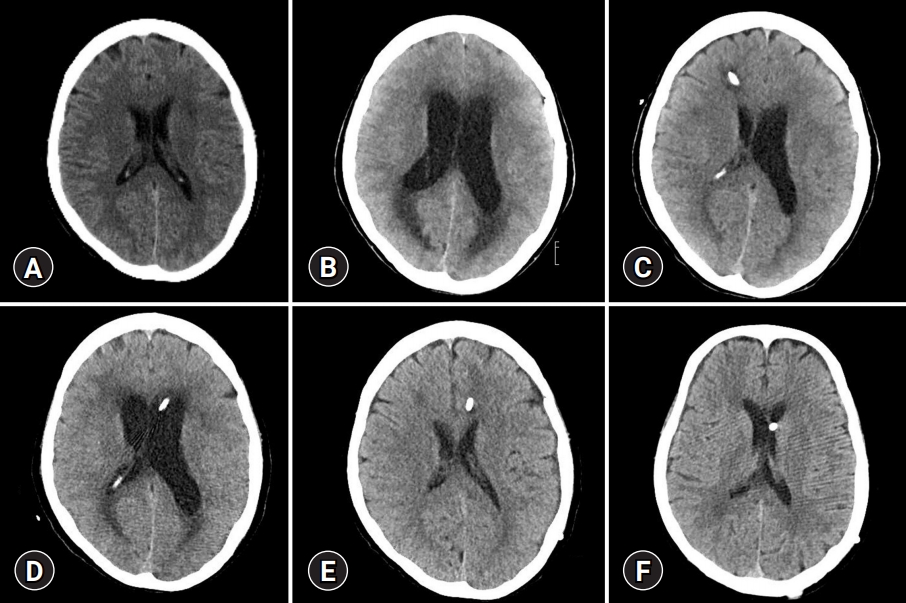
- 4,415 View
- 91 Download
- 1 Web of Science
- 2 Crossref
-
 Abstract
Abstract
 PDF
PDF - This report describes a case of coinfection of Sphingomonas paucimobilis meningitis and Listeria monocytogenes bacteremia in a 66-year-old immunocompetent female patient. The patient had undergone traditional procedures, including acupuncture, which possibly caused the coinfection. During treatment with susceptible antibiotics for bacterial meningitis, she developed hydrocephalus on the third day. Consequently, the patient recovered with a mild neurological deficit of grade 4 motor assessment in both upper and lower extremities at discharge. S. paucimobilis and L. monocytogenes are rare pathogens in developed countries, occurring only during environmental outbreaks. S. paucimobilis meningitis is rarely reported. Hence, the various presentations of S. paucimobilis meningitis and the antibiotic regimen for its treatment are hereby reported, in addition to a review of other similar reported cases. This case is a possible traditional procedure-related infection. Appropriate oversight and training should be emphasized regarding preventive measures of this kind of infection. A team approach with neurologists and neurosurgeons is imperative in treating patients with hydrocephalus-complicated meningitis.
-
Citations
Citations to this article as recorded by- Concurrent Sphingomonas paucimobilis and Mycobacterium tuberculosis Meningitis in an Immunocompromised Patient: A Rare Case Report and Comprehensive Review of Literature
Iosif Marincu, Felix Bratosin, Iulia Bogdan, Catalin Dumitru, Carmen Nicoleta Stoica, Andrei Nicolae Csep, Narcisa Mederle, Roxana Manuela Fericean, Alexandru Ovidiu Mederle, Reshmanth Prathipati, Gratiana Nicoleta Chicin, Adelina Mavrea, Paula Irina Bara
Medicina.2023; 59(4): 687. CrossRef - Publication status and reporting quality of case reports on acupuncture-related adverse events: A systematic reviews of case studies
Tae-Hun Kim, Myeong Soo Lee, Stephen Birch, Terje Alræk, Arne Johan Norheim, Jung Won Kang
Heliyon.2023; 9(10): e20577. CrossRef
- Concurrent Sphingomonas paucimobilis and Mycobacterium tuberculosis Meningitis in an Immunocompromised Patient: A Rare Case Report and Comprehensive Review of Literature
- Enteritis cystica profunda with lipoma in the second portion of the duodenum: a case report
- Beom Jin Shim, Seung Keun Park, Hee Ug Park, Tae Young Park
- J Yeungnam Med Sci. 2022;39(1):72-76. Published online June 9, 2021
- DOI: https://doi.org/10.12701/yujm.2021.01067
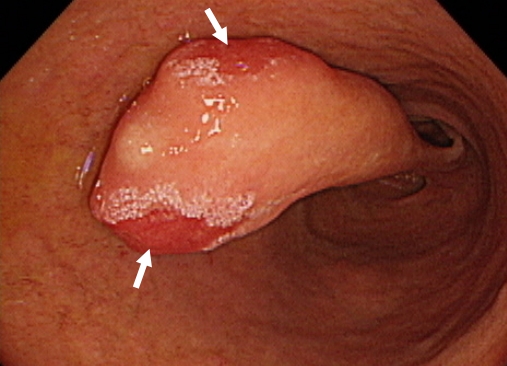
- 4,510 View
- 77 Download
- 2 Web of Science
- 3 Crossref
-
 Abstract
Abstract
 PDF
PDF - Enteritis cystica profunda (ECP), a rare and benign condition, is defined as the displacement of the glandular epithelium into the submucosa and more profound layers of the small intestinal wall leading to the formation of mucin-filled cystic spaces. ECP frequently occurs in the ileum or jejunum and is associated with diseases such as Crohn disease and Peutz-Jeghers syndrome. ECP also develops in the absence of known pathology. ECP in the duodenum is very rare and mostly occurs without associated conditions. In this report, we present a rare case of ECP without an associated disease, in the second portion of the duodenum distal to the ampulla of Vater and coexisting with lipoma within the polypoid lesion.
-
Citations
Citations to this article as recorded by- L’entérite kystique profonde
Axel Dréau, Clémence Barthomeuf, Marion Balesdent, Mathurin Fumery, Charles Sabbagh, Denis Chatelain
Annales de Pathologie.2024; 44(1): 65. CrossRef - Colitis Cystica Profunda Mimicking Malignancy
Sheenam Azad, Brijesh Thakur, Seema Acharya, Shefali Kamboj, Rajiv Kumar Azad
Indian Journal of Medical Specialities.2024; 15(1): 63. CrossRef - Enteritis cystica profunda: Case report and literature review
Ricardo E. Núñez-Rocha, Felipe Girón, Mario Latiff, Carlos Eduardo Rey, Lina Rodríguez, Juan David Hernández
International Journal of Surgery Case Reports.2023; 106: 108148. CrossRef
- L’entérite kystique profonde
- Stent graft treatment of an ilioenteric fistula secondary to radiotherapy: a case report
- Joo Yeon Jang, Ung Bae Jeon, Jin Hyeok Kim, Tae Un Kim, Jae Yeon Hwang, Hwa Seong Ryu
- J Yeungnam Med Sci. 2022;39(1):77-80. Published online July 7, 2021
- DOI: https://doi.org/10.12701/yujm.2021.01053

- 3,444 View
- 60 Download
- 1 Crossref
-
 Abstract
Abstract
 PDF
PDF - Fistulas between the arteries and the gastrointestinal tract are rare but can be fatal. We present a case of an ilioenteric fistula between the left external iliac artery and sigmoid colon caused by radiotherapy for cervical cancer, which was treated with endovascular management using a stent graft. A 38-year-old woman underwent concurrent chemoradiotherapy for cervical cancer recurrence. Approximately 9 months later, the patient suddenly developed hematochezia. On her first visit to the emergency room of our hospital, computed tomography (CT) images did not reveal extravasation of contrast media. However, 8 hours later, she revisited the emergency room because of massive hematochezia with a blood pressure of 40/20 mmHg and a heart rate of 150 beats per minute. At that time, CT images showed the presence of contrast media in almost the entire colon. The patient was referred to the angiography room at our hospital for emergency angiography. Inferior mesenteric arteriography did not reveal any source of bleeding. Pelvic arteriography showed contrast media extravasation from the left external iliac artery to the sigmoid colon; this was diagnosed as an ilioenteric fistula and treated with a stent graft. When the bleeding focus is not detected on visceral angiography despite massive arterial bleeding, pelvic arteriography is recommended, especially in patients with a history of pelvic surgery or radiotherapy.
-
Citations
Citations to this article as recorded by- Resection of sigmoid cancer with bladder invasion using laparoscopic combined with a cystoscopic holmium laser: an innovative surgical procedure
Ronghua Wu, Cong Xu, Xing Liu, Weihua Fu, Yujia Chen, Jingzhen Zhu, Guangsheng Du
Lasers in Medical Science.2023;[Epub] CrossRef
- Resection of sigmoid cancer with bladder invasion using laparoscopic combined with a cystoscopic holmium laser: an innovative surgical procedure

 E-Submission
E-Submission Yeungnam University College of Medicine
Yeungnam University College of Medicine


 First
First Prev
Prev



